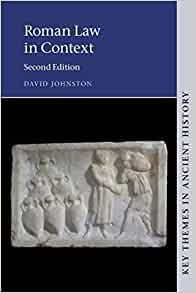Some 23 years after the first edition of Roman Law in Context, David Johnston makes his case for the second by pointing to the considerable advances in the study of Roman social and economic history in the interim. Considering the significant new epigraphic material and scholarship which has emerged over recent decades, the point is well taken.

Roman Law in Context (2nd edition) is designed to be an accessible guide to the Roman law for students and teachers of history, and general readers. As such, Johnston must be selective when it comes to content. With a nod to those who dubbed the first edition too brief, the author begins on a lighthearted note with an introduction entitled “What Is Not In This Book”, in which he both reiterates the value of a short survey of the law and reassures the reader that this second edition is longer! Although some 70 pages more substantial than its 1999 counterpart (including a whole new chapter on public law), it remains a comparatively succinct treatment at just 222 pages. The bulk of this additional content is valuable updates to the existing text to take account of contemporary thinking and modern contributions to the historiography. As in the previous edition, the work focuses on the classical period but incorporates the occasional discussion of post-classical law.
Considering its brevity, the work’s scope is impressive. Chapter 1 eases the reader in with an overview of sources of law, expanding upon, inter alia, the Twelve Tables, jurists of various periods, the role of the Emperor as adjudicator, and traditional and recent perspectives on the role of statute in private law. Johnston’s elaboration on the issues of Romanization of the provinces of the Empire, and the grant of citizenship make a fine example of the book’s purpose. In line with scholarly thinking at the time, the first edition suggested that the Spanish provinces were a special case – “an extreme of Romanization”. However, as Johnston points out, recovery of the lex Troesmensis, further bronze tablets recently found in Spain, as well as recent scholarship on theconstitutio Antoniniana and the co-existence of Roman law with local, indigenous systems, provide an important corrective to this picture. The more nuanced picture adds significant value as a result, without negatively affecting accessibility.
Chapter 2, on Sources and Methodology, is concerned with the surviving literary and documentary evidence, focusing on how modern scholars use Roman legal sources, and the issues which arise in doing so. It first gives an account of sources which have survived independently of Justinian, before embarking upon a deep dive on the Digest, and whistle-stop tour of other Justinianic sources. Considering the justification for this second edition, it is perhaps surprising that the chapter is only a few pages longer than previously. It is, however, rich in content, with up-to-date references regarding the Vindolanda tablets, the Bloomberg tablets, and recent treatments of earlier-discovered evidence.
Chapter 3 outlines the Roman family, slaves, and succession, including up-to-date recommended reading on the powers of the paterfamilias, the effect of marriage on property, and the vast literature around slavery, of which only the briefest account is given in light of the vast literature available elsewhere.

Chapter 4 deals with ownership, use of land, and legal remedies against the unwelcome activities of neighbours, with noteworthy additions on landlord-tenant relations, and many references to the respective works of Kehoe and du Plessis on the subject.
Chapter 5 considers legal issues arising in connection with Roman commerce. This chapter’s scope is not merely impressive but mind-boggling: contracts in general, commercial contracts, contracts for services, the organization of Roman businesses, and the law of insolvency are all explored. Here, for the first time, some of the economic analysis of the law referenced feels quite specialised. The uninformed reader (and perhaps even scholars concerned with other areas of Roman law) may be at risk of being overwhelmed.
Chapter 6 addresses Litigation, outlining civil procedure in the Classical period and how those rules were enforced in practice. The addition of Bablitz’s (2007) and Metzger’s voices (2005, 2013, 2016) to Crook’s (1967, 1995), as well as discussion of recent epigraphic evidence bearing upon access to justice give this brief overview a pleasingly robust feel. Chapter 7 is completely original, tackling substantive and procedural aspects of Crime, Delict, Regulation, and Public Order. The chapter feels heavily weighted towards crime and criminal procedure, giving only the briefest summary of delict. Nevertheless, most of the main categories are present and correct. Since the work focuses largely on the classical period up to AD 235, the post-classical category of quasi-delicts is absent from the survey, but feels notably so given the comprehensive surrounding content.
Johnston concludes with an Epilogue discussing the periodization and legacy of the Roman law tradition, specifically its role in the formation of European private law. A short glossary offers limited assistance with Latin legal terminology, but is, as Johnston acknowledges, far from exhaustive. Finally, the 9-page Bibliographical Essay, discussing the sources referenced throughout the book, broken down chapter-by-chapter, is nothing short of a gold mine for those in search of further reading. A significant number of these sources are recent, but many are older, offering a truly invaluable resource for those interested in tracing how the discussion has evolved over recent decades.
As a beginner’s guide, this 2nd edition is very successful at what it sets out to do. First, it provides a necessary update on the state of the scholarly discussion, without which the reader would be at a serious disadvantage. Second, despite the relatively complex subject matter, Johnston’s presentation is generally simple and accessible, offering an enjoyable introduction for the uninitiated and a quick refresher for more seasoned readers.


